Alcohol and late night refreshment licensing England and Wales 31 March 2014
Published 11 December 2014
Applies to England and Wales
1. Introduction
This release contains statistics on the following licensing authority powers under the Licensing Act 2003:
- premises licences
- club premises certificates
- personal licences
- late night refreshment and 24-hour alcohol licences
- temporary event notices (TENs)
- early morning alcohol restriction orders (EMROs)
- late night levies
It also includes statistics on:
- reviews, hearings and appeals
- cumulative impact areas
Headline figures, which include modelled estimates for non-responding licensing authorities (LAs), show that on 31 March 2014, in England and Wales, there were in force:
- 204,300 premises licences, 0.1% (300) more than the previous year
- 15,400 club premises certificates, 2% (-300) fewer than the previous year
- 581,000 personal licences, 6% (33,700) more than the previous year
The main purpose of this collection is to monitor the administration of the Licensing Act 2003 (the 2003 Act) and subsequent amendments, such as those introduced by the Police Reform and Social Responsibility Act 2011 (the 2011 Act). The Government also uses the information for impact assessments and for the formulation and evaluation of policy. In addition, the collection also helps licensing authorities to benchmark their position and understand the national context.
Further information on the types of licence, as well as a glossary of terms, and conventions used in the statistics are available in the User Guide to Alcohol and Late Night Refreshment Licensing Statistics (referred to as the user guide from this point on). Section 8, data quality and interpreting the figures, at the bottom of this release, provides information on response rates, modelling, bias and underestimates. It also includes a revisions analysis.
The figures within this release, as well as additional ones, are provided within the Alcohol and late night refreshment licensing England and Wales 31 March 2014 tables. Datasets at LA level are provided within the Alcohol and late night refreshment licensing England and Wales 31 March 2014 supplementary tables.
To reduce the administrative burden both on LAs and the Home Office statistics team, the Home Office will not be running the alcohol and late night refreshment licensing collection for year ending March 2015. The main use of the collection is to monitor the impact of new and amended legislation and consequently it has never been the Home Office’s intention to run it every year. The Home Office will be resuming the collection for year ending March 2016.
The Department for Culture, Media and Sport (DCMS) previously produced these statistics but in 2010 responsibility for alcohol licensing and late night refreshment was transferred to the Home Office whilst responsibility for regulated entertainment was retained by DCMS. DCMS plans to publish entertainment licensing figures as at 31 March 2014 on 18 December 2014.
The Scottish Government annually publishes Scottish Liquor Licensing Statistics under the Licensing (Scotland) Act 2005. These include headline figures on the number of premises and personal licences in force. The former includes licences for registered clubs, the equivalent to club-registered certificates, which are collected separately in England and Wales. The release also includes figures on the number of premises licences applied for, granted, and refused. The Scottish Liquor Licensing Statistics are broadly comparable with those for England and Wales. The Northern Ireland Executive does not publish alcohol/liquor licensing statistics.
2. Premises licences
2.1 Introduction
A premises licence gives authority for a premises to be used for the sale or supply of alcohol, the provision of regulated entertainment, or the provision of late night refreshment, under the 2003 Act.
This section contains statistics on premises licences, issued by LAs in England and Wales, that were in force on 31 March 2014, and comparisons with previous years’ figures. The headline figure for 31 March 2014 uses data received from all 350 LAs.
Based purely on data from the responding LAs, also presented here are breakdowns on the numbers of premises licences in force on 31 March 2014 by fee band. Figures on premises licence activity and outcome are also provided. The response rate for these figures ranges from 81% to 100%. See the Licence Questionnaire for the response rate for each figure.
2.2 Key facts
Based on data received from all 350 LAs there were 204,300 premises licences in force in England and Wales on 31 March 2014, a slight increase of 0.1% (300) compared with the previous year, and an increase of 3% (6,300) compared with 31 March 2009.
Number of premises licences, England and Wales, 31 March 2009 to 2014

Chart notes
2010, 2012 and 2013 figures include modelled estimates for non-responding LAs.
Data were not collected for 31 March 2011.
Source: Home Office, Alcohol and late night refreshment licensing England and Wales 31 March 2014 tables.
Based on data received from LAs and estimates for the remaining non-respondents, within the 31 March 2014 total for premises licences:
- 37,700 premises were licensed for on-sales of alcohol only, down 4% (-1,500) compared with the previous year
- 52,400 premises were licensed for off-sales or supply of alcohol only, down 3% (-1,700)
- 78,500 premises were licensed for both on- and off-sales or supply of alcohol, down 0.1% (-100)
The remaining premises licences were not permitted to sell or supply alcohol or had alcohol permissions which were not reported.
2.3 Premises licences by fee band
There are 5 distinct fee bands for premises, which are based on the non-domestic rateable value of the premises. The glossary of the user guide contains more detail on fee bands, including the costs of each band, which range from an application fee of £100 and an annual fee of £70 for Band A to an application fee of £1,905 and an annual fee of £1,050 for Band E with a multiplier. Multipliers are applied to premises used exclusively or primarily for the supply of alcohol for consumption on the premises under the authorisation of a premises licence.
Based on data provided by all 350 LAs, there were 204,282 premises licences in force on 31 March 2014, and of these, fee band information was provided for 167,026 licences. Over half (54% or 89,785) were in Band B. The next largest fee band was Band A, which accounted for around a fifth (21% or 34,523) of premises. Of the premises licences in force on 31 March 2014, 10,897 (7% of the premises total) did not attract a fee, even though a fee band was set.
Premises licences by fee band, England and Wales, 31 March 2014

Chart notes
Bands D and E include licences for premises where fee multipliers are applied.
Premises licences that do not attract a fee still have a fee band set and these are included.
The percentages in the pie chart do not add up to 100% because of rounding.
Source: Home Office, Alcohol and late night refreshment licensing England and Wales 31 March 2014 tables.
2.4 Premises licence activity and outcome
Based only on the LAs which provided data, 9,638 applications for new premises licences were received in the year to 31 March 2014. Of these 8,763 were granted, equating to 4% of the total number of premises licences which were in force on 31 March 2014, 275 were refused, and the outcome was unknown or to be decided for a further 600.
There were 5,190 applications made to change the terms of a premises licence, of which 4,738 were granted, 169 were refused and the outcome was unknown or to be decided for a further 283.
In the year to 31 March 2014, 5,166 premises licences were surrendered by the holder, 621 lapsed, 11 were suspended by a court, 4,027 were suspended by a licensing authority, and 42 were affected by a closure notice.
3. Club premises certificates
3.1 Introduction
A club premises certificate allows a qualifying club to carry out activities specified under the 2003 Act. This section contains statistics on club premises certificates, issued by LAs in England and Wales, that were in force on 31 March 2014, and comparisons with previous years’ figures. The headline figure for 31 March 2014 uses data received from all 350 LAs.
Based purely on data from the responding LAs, also presented here are breakdowns on the numbers of club premises certificates in force on 31 March 2014 by fee band. Figures on club premises certificate activity and outcome are also provided. The response rate for these figures ranges from 82% to 100%. See the Licence Questionnaire for the response rates for each figure.
3.2 Key facts
Based on data received from all 350 LAs, there were 15,400 club premises certificates in force in England and Wales on 31 March 2014, a decrease of 2% (-300) compared with the previous year and a decrease of 11% (-1,900) compared with 31 March 2009.
Number of club premises certificates, England and Wales, 31 March 2009 to 2014
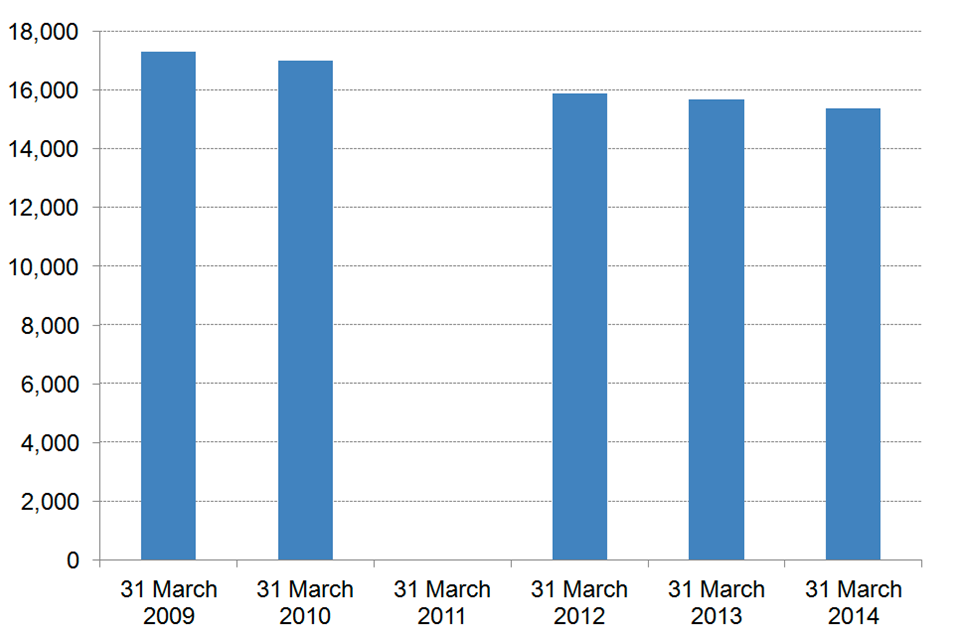
Chart notes
2010, 2012, and 2013 figures include modelled estimates for non-responding LAs.
Data were not collected for 31 March 2011.
Source: Home Office, Alcohol and late night refreshment licensing England and Wales 31 March 2014 tables.
Based on data received from LAs and estimates for the remaining non-respondents, within the 31 March 2014 total for club premises certificates:
- 7,200 club premises were certificated for on-sales or supply of alcohol only, down 1% (-100) compared with the previous year
- 7,800 premises were licensed for both on- and off-sales or supply of alcohol, down 3% (-200)
The remaining club premises certificates were not permitted to sell or supply alcohol or had alcohol permissions which were not reported.
3.3 Club premises certificates by fee band
There are 5 distinct fee bands for club premises certificates, which are based on the non-domestic rateable value of the premises. The glossary of the user guide contains more detail on fee bands, including the costs of each band, which range from an application fee of £100 and an annual fee of £70 for Band A to an application fee of £1,905 and an annual fee of £1,050 for Band E with a multiplier.
Based only on the LAs which provided data, there were 15,358 club premises certificates in force on 31 March 2014, and of these, fee band information was provided for 12,847. Nearly two-thirds (62% or 7,929) were in Band B. The next largest fee band was Band A, which accounted for almost a third (31% or 3,939) of premises.
Of the club premises certificates in force on 31 March 2014, 77 (1% of the club premises total) did not attract a fee, even though a fee band was set.
Club premises certificates by fee band, England and Wales, 31 March 2014

Chart notes
Bands D and E include licences for premises where fee multipliers are applied.
Club premises certificates that do not attract a fee still have a fee band set and these are included.
Source: Home Office, Alcohol and late night refreshment licensing England and Wales 31 March 2014 tables.
3.4 Club premises activity and outcome
Based only on data provided from LAs, 114 applications for new club premises licences were received. Of these, 108 were granted, equating to 1% of the total number of club premises certificates which were in force on 31 March 2014, 2 were refused and the outcome was unknown or to be decided for a further 4.
There were 137 variation applications made to change the terms of a certificate, of which 132 were granted, none were refused, and the outcome was unknown or to be decided for a further 5.
In the year to 31 March 2014, 242 club premises certificates were surrendered by clubs, 29 lapsed, 168 were suspended by a licensing authority, and 25 were withdrawn.
4. Personal licences
4.1 Introduction
A personal licence authorises an individual to supply or authorise the supply of alcohol in accordance with a premises licence under the 2003 Act.
This section contains statistics on the numbers of personal licences, issued by LAs in England and Wales, that were in force on 31 March 2014, and comparisons with previous years’ figures. The headline figure for 31 March 2014 combines the data received from 99% of LAs (347 out of 350) with estimates for the remaining non-respondents.
Based purely on data from the responding LAs, also presented here are figures on personal licence activity. The response rate for these figures was also 99%.
4.2 Key facts
Based on data received from LAs and estimates for the non-respondents, there were 581,000 personal licences in force in England and Wales on 31 March 2014, 6% (33,700) more than the previous year, and 48% (189,400) more than on 31 March 2009.
Number of personal licences, England and Wales, 31 March 2009 to 2014
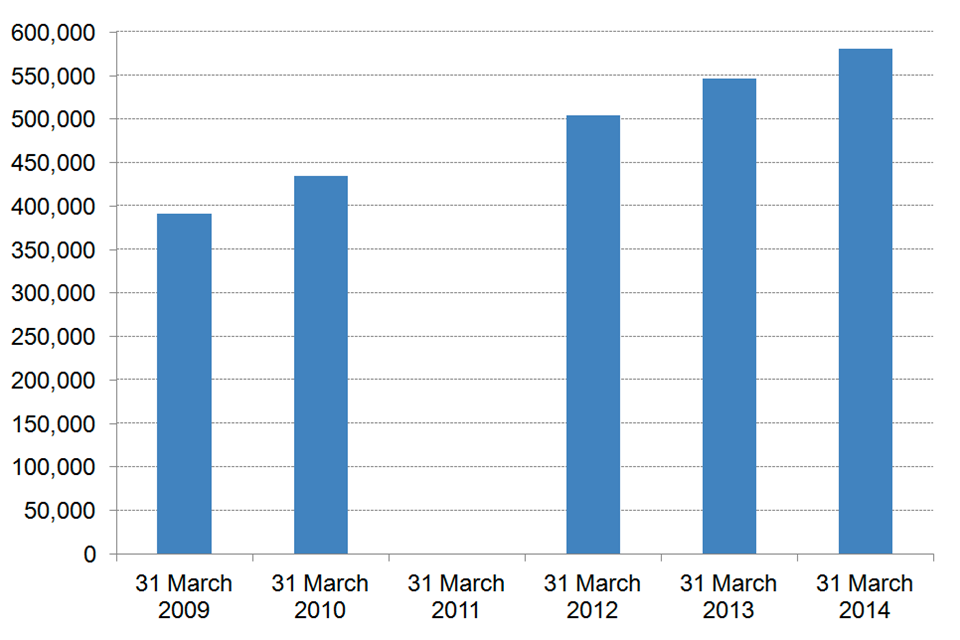
Chart notes
2010, 2012, 2013 and 2014 figures include modelled estimates for non-responding LAs.
Data were not collected for 31 March 2011.
Source: Home Office, Alcohol and late night refreshment licensing England and Wales 31 March 2014 tables.
4.3 Personal licences activity
Based only on LAs which provided data, in the year to 31 March 2014, 257 personal licences were surrendered, 6 were revoked, 2 were forfeited and 14 were suspended by a court.
5. Late night refreshment and 24-hour alcohol licences
5.1 Introduction
Late night refreshment refers to the provision of hot food or drink to the public, for consumption on or off the premises, between 11pm and 5am or the supply of hot food or hot drink to any persons between those hours on or from premises to which the public has access. A 24-hour licence refers to premises that are licensed for the sale or supply of alcohol for 24 hours in their standard timing.
This section contains statistics on the numbers of premises licences with late night refreshment and on 24-hour alcohol licences, issued by LAs in England and Wales, that were in force on 31 March 2014, and comparisons with previous years’ figures. These headline figures for 31 March 2014 combine data received from LAs (96% or 335 out of 350 for late night refreshment and 96% or 337 for 24-hour alcohol licences) with estimates for the remaining non-respondents.
Based purely on data from the responding LAs, also presented here are breakdowns on late night refreshment and 24-hour alcohol licences. The response rate for these figures ranges from 85% to 96%. See the Licence Questionnaire for the response rates for each figure.
5.2 Key facts
Based on data received from LAs and estimates for the non-respondents, there were 87,700 licences with late night refreshment in force on 31 March 2014, an increase of 1% (1,200) compared with the previous year’s figure and 7% (6,100) more than on 31 March 2009. The number of licences with late night refreshment in force on 31 March 2014 equated to 43% of the total number of premises licences.
Number of late night refreshment licences, England and Wales, 31 March 2009 to 2014
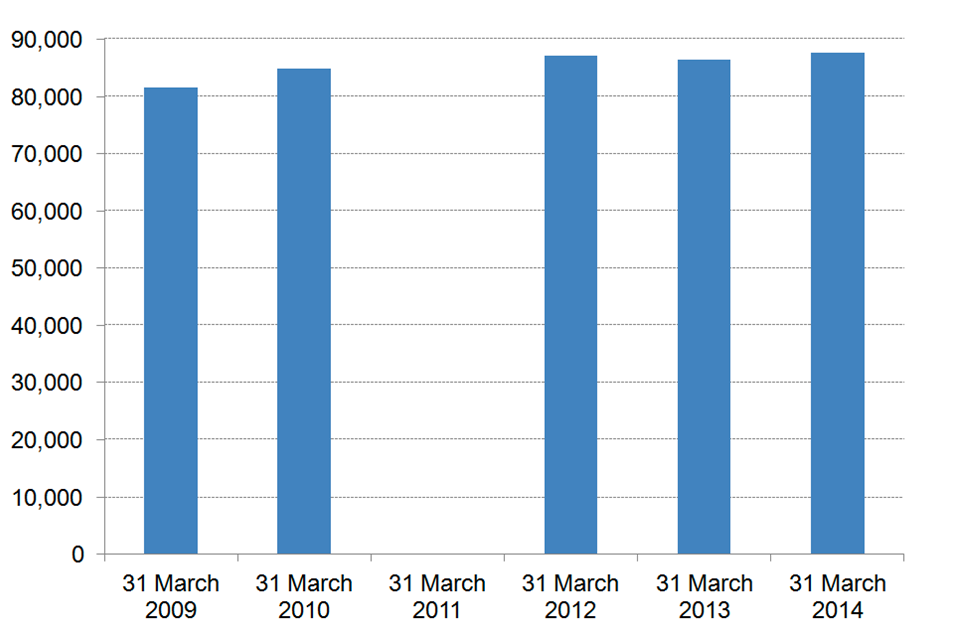
Chart notes
Figures for all years include modelled estimates for non-responding LAs.
Data were not collected for 31 March 2011.
Source: Home Office, Alcohol and late night refreshment licensing England and Wales 31 March 2014 tables.
Based on data received from LAs and estimates for the non-respondents, there were 8,200 premises with 24-hour alcohol licences in force in England and Wales on 31 March 2014, a slight decrease of 2% (-200) from the previous year, but an increase of 8% (600) compared with 31 March 2009. The number of premises with 24-hour alcohol licences in force on 31 March 2014 equated to 4% of the total number of premises licences.
Number of 24-hour alcohol licences, England and Wales, 31 March 2009 to 2014
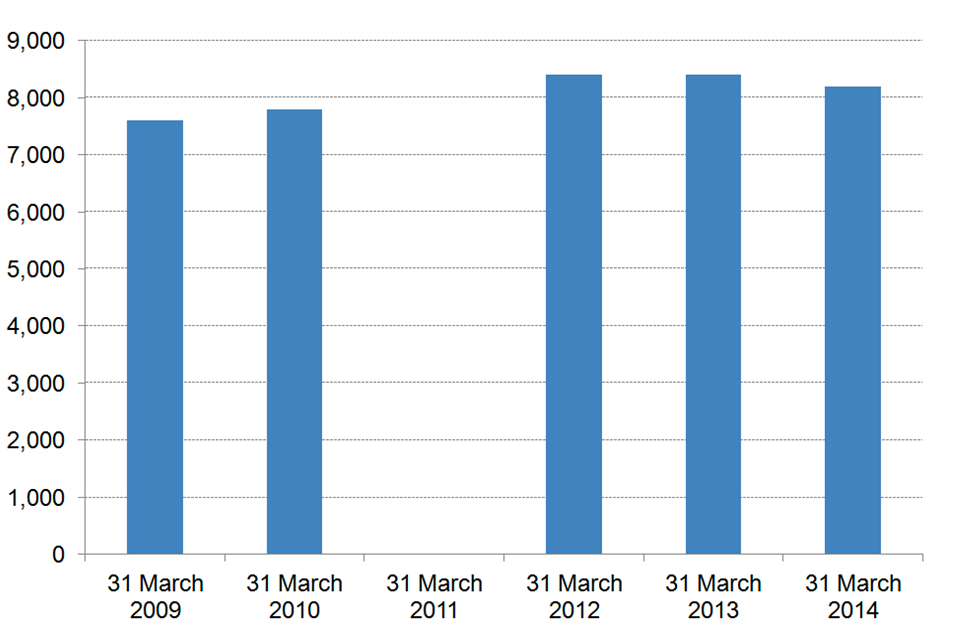
Chart notes
Figures for all years include modelled estimates for non-responding LAs.
Data were not collected for 31 March 2011.
Source: Home Office, Alcohol and late night refreshment licensing England and Wales 31 March 2014 tables.
5.3 Late night refreshment
Based only on LAs which provided data, there were 82,390 premises licences with late night refreshment in force on 31 March 2014, and of those, 17,135 premises had authorisation only for late night refreshment activity.
5.4 24-hour alcohol licences
Based only on LAs which supplied data, there were 7,438 24-hour alcohol licences in force on 31 March 2014, and of these the premises type was known for 7,353 licences.
On 31 March 2014, 47% (3,446) of all 24-hour alcohol licences were in hotel bars, of which, for where it was known, 85% (2,567) were open 24 hours for guests only and the remaining 15% (462) were open to the public as well as guests.
Supermarkets and stores accounted for 28% (2,065) of 24-hour alcohol licences, of which, for where it was known, 53% (957) were for convenience stores and the remaining 47% (849) were for large supermarkets. Pubs, bars, and nightclubs accounted for 11% (831) of 24-hour alcohol licences.
Premises with 24-hour alcohol licences by premises type, England and Wales, 31 March 2014
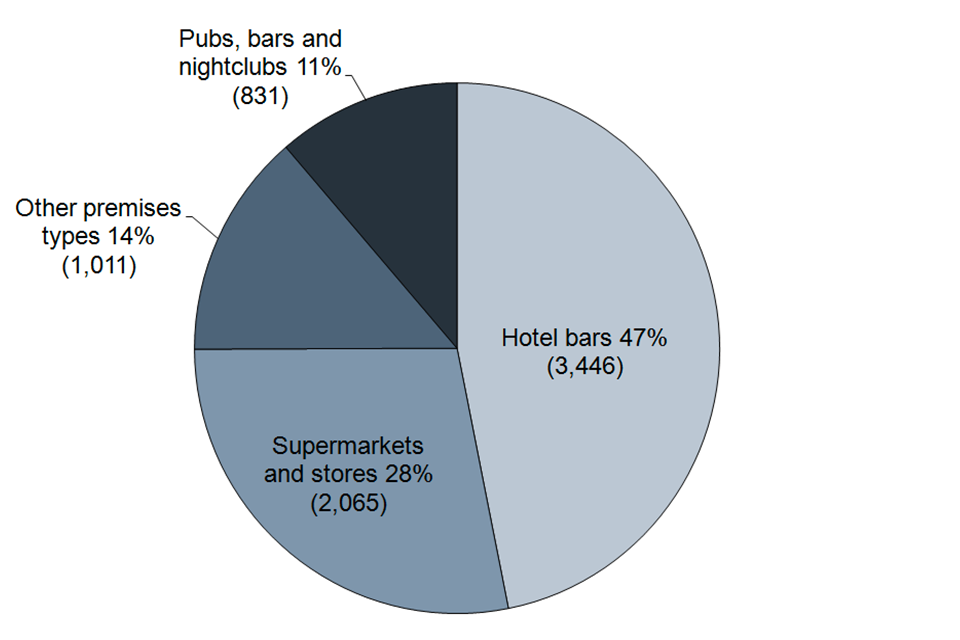
Chart notes
Source: Home Office, Alcohol and late night refreshment licensing England and Wales 31 March 2014 tables.
6. Reviews, hearings and appeals
6.1 Introduction
This section contains statistics on the number of reviews completed by LAs in England and Wales in the year to 31 March 2014, and comparisons with the previous year’s figure. The headline figure for 31 March 2014 uses data received from all 350 LAs.
Based purely on data from the responding LAs, it also contains statistics on the type of licence reviewed, the reason for the review, the instigating body, and the actions taken following the review. Statistics are also presented on expedited reviews and on hearings, appeals and judicial reviews. The response rates for these figures range from 94% to 100%. See the Licence Questionnaire for the response rates for each figure.
6.2 Key facts
Based on data received from all 350 LAs, 800 reviews were completed in the year to 31 March 2014, 11% (-100) fewer than the previous year and 27% (-300) fewer than 31 March 2009.
6.3 Completed reviews
A licensing authority can be asked to review a licence on the grounds of it having an adverse impact. The figures in this section refer to reviews that were completed in the year to 31 March 2014.
Based only on LAs which were able to supply information on the type of the completed review:
- 84% (684) were for premises licences following a general application for a review
- 13% (108) were for premises licences following an application by the police for an expedited review
- 1% (10) were for premises licences following a closure order
- 1% (8) were for club premises certificates following a general application for a review
Regarding the reason for completed reviews (or reasons as more than one was cited in some instances), 653 were for crime and disorder, 314 were for protection of children, 258 were for public nuisance, and 193 were for public safety.
The police were the main responsible authority, instigating 58% (468) of the total number of reviews, with trading standards being the second most common responsible authority, instigating 21% (167). Environmental health officers and local residents both instigated 7% (53) each.
Completed reviews instigated by each responsible authority, England and Wales as at 31 March 2014
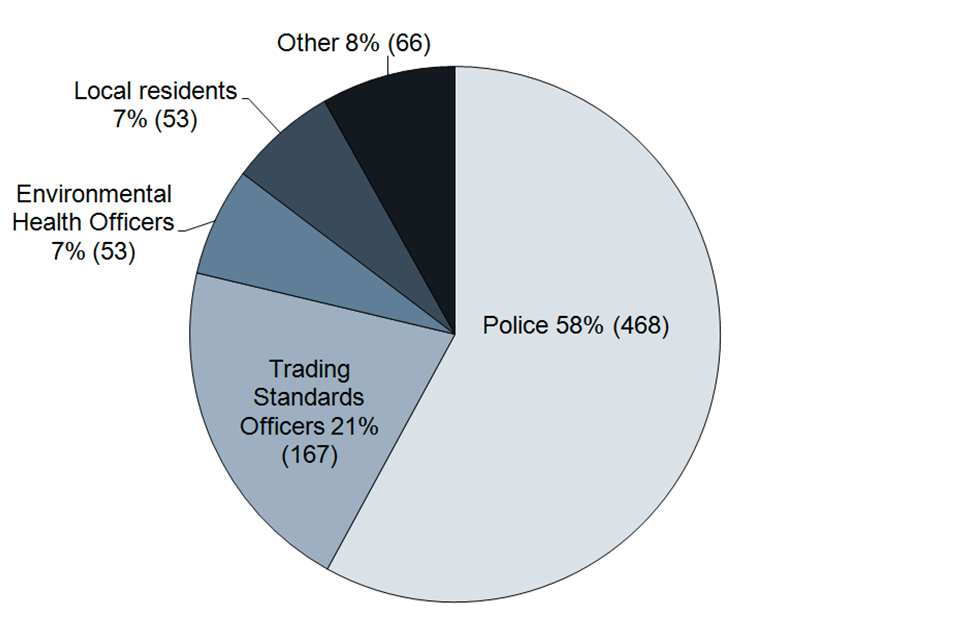
Chart notes
The percentages in the pie chart do not add up to 100% because of rounding.
Source: Home Office, Alcohol and late night refreshment licensing England and Wales 31 March 2014 tables.
Regarding the action (or actions) taken following reviews, the majority (689) resulted in conditions being added to the licence or modified, 198 resulted in a licence being revoked or a club premises certificate being withdrawn, 101 resulted in a licence or certificate being suspended and, for premises licences only, 65 resulted in the designated supervisor being removed. No action was taken following 52 reviews.
6.4 Expedited reviews
Expedited review powers allow the police to trigger a fast-track process to review a premises licence where they consider a premises to be associated with serious crime and/or serious disorder, and allow the licensing authority to quickly respond by taking interim steps, where appropriate, pending a full review. Interim steps are temporary measures which have to be taken within 48 hours of the expedited review being accepted.
Based only on LAs which provided data, there were 114 applications for an expedited review in the year to 31 March 2014, and 2 of these applications were withdrawn or rejected.
Interim steps were taken for 106 expedited reviews and none were taken in 6 cases. Where interim steps were taken:
- in 69 cases the licence was suspended
- in 30 cases other conditions were added or modified
- in 17 cases the operating hours were modified
- in 15 cases the designated premises supervisor was removed
- in 6 cases the licensable activity was partially restricted
- in 5 cases the licensable activity was completely excluded
6.5 Hearing, appeals and judicial reviews
Based only on data from responding LAs, in the year to 31 March 2014, 3,435 premises licence/club premises certificate applications went to a committee hearing and 107 personal licence applications went to a committee hearing.
There were 111 completed appeals against the application decision and 117 completed appeals against the licence review decision. In the year to 31 March 2014, 262 LAs reported that no appeals were made against any decision. Regarding judicial reviews, 3 were completed.
7. Other topics
7.1 Introduction
This section contains statistics on the number of cumulative impact areas, early morning alcohol restriction orders (EMROs) and late night levies as at 31 March 2014 and, in the year to 31 March 2014, statistics on the number of temporary event notices (TENs).
7.2 Cumulative impact areas
A cumulative impact area is an area that the LA has identified in their licensing policy statement as having a saturation of licensed premises and the ‘cumulative impact’ of any additional licensed premises could affect the licensing objectives.
The figure on the number of cumulative impact areas uses data from nearly all LAs (349 out of 350 or 99.7%).
There were 208 cumulative impact areas in place on 31 March 2014.
7.3 Temporary event notices
TENs are used to authorise certain relatively small-scale events involving licensable activities, subject to certain criteria and limits. Late TENs allow TENs’ users to give their notices 5 days ahead of the start of the temporary event period rather than the usual 10 days. Unlike standard TENs, there is no right to appeal and they cannot proceed if the police or the environmental health authority object to it. The 2011 Act introduced late TENs in April 2012.
The headline figure for the number of TENs used in the year to 31 March 2014 combines data received from LAs (99% or 348 for standard notice TENs and 97% or 341 for late notice TENs) with estimates for the remaining non-respondents.
There were 132,200 TENs used in the year to 31 March 2014, 5% (-7,100) fewer than in the previous year, but 8% (10,100) more than in the year to 31 March 2009.
7.4 Early morning alcohol restriction orders
EMROs enable LAs to prohibit the sale of alcohol for a specified time period between midnight and 6am in the whole or a part of their area, if they consider this appropriate for the promotion of their licensing objectives. EMROs provide LAs with an additional tool to shape and determine local licensing, and help to address specific problems caused by late night drinking. The 2011 Act commenced EMROs in October 2012.
The figure on the number of EMROs uses data received from all 350 LAs.
As at 31 March 2014, there were no EMROs in place.
7.5 Late night levies
Late night levies allow LAs to raise a contribution from late-opening alcohol suppliers towards policing the night-time economy. Late night levies must cover the entire area of a licensing authority and apply for a specified period between midnight and 6am. The 2011 Act introduced late night levies in October 2012.
The figure on the number of late night levies uses data received from all 350 LAs.
As at 31 March 2014, Newcastle-upon-Tyne was the sole LA to have a late night levy in place. The amount raised by the levy was £300,000.
8. Data quality and interpreting the figures
8.1 Response rate and modelling
The overall response rate was 100%: all 350 LAs provided data. However, some were unable to provide data for all of the requested fields (see the Licence Questionnaire for the response rate for each figure).
To allow meaningful comparisons to be made between years, the larger headline figures within this release include modelled estimates for the LAs which were unable to supply data (see the user guide for an explanation of the methodology).
8.2 Bias and underestimates
We do not expect that the modelling process will introduce bias as the modelled estimates for non-responding LAs are only calculated for larger headline totals, which have high response rates (ranging from 93% to 100%) for the (year ending) 31 March 2014 figures.
For the figures which are based purely on data received from responding LAs, the numbers will underestimate the overall picture for England and Wales, especially for figures with lower response rates (the lowest being 81%).
8.3 Revisions analysis
Six per cent of LAs (20) submitted revisions to last year’s figures. This resulted in 31 changes to the (total) figures for (the year ending) 31 March 2013, ranging from an increase of 4% (582) for the number of valid TENs (late) to a decrease of 89% (-25) for the number of premises licenses suspended after a court hearing.
The modelled estimates for 31 March 2012 and 31 March 2013 have been revised in this year’s release as the calculations now also incorporate 31 March 2014 data where possible. This is because LAs have indicated that the figures they submit become more accurate over time so using the latest available data to calculate the modelled estimates improves their accuracy. The tables below show how the headline figures, which include modelled estimates for the non-responding LAs, have changed ranging from a decrease of 10% to an increase of 0.4% for 2012 and a decrease of 9% to an increase of 13% for 2013. See the user guide for an explanation of the modelling procedure.
Comparison between initial and revised headline figures, which include modelled estimates for non-responding LAs, for 31 March 2012
| 31 March 2012: last year’s publication | 31 March 2012: this year’s publication | Change | % Change | |
|---|---|---|---|---|
| Premises licences | 202,500 | 201,500 | -1,000 | -0.5% |
| Club premises certificates | 16,000 | 15,900 | -100 | -1% |
| Personal licences | 510,300 | 505,000 | -5,300 | -1% |
| Premises licences on-sales of alcohol only | 36,500 | 36,600 | 100 | 0.3% |
| Premises licences off-sales or supply of alcohol only | 51,500 | 50,700 | -800 | -2% |
| Premises licences both on- and off-sales or supply of alcohol | 82,000 | 81,400 | -600 | -1% |
| Club premises certificates on-sales of alcohol only | 7,500 | 7,400 | -100 | -1% |
| Club premises certificates both on- and off-sales or supply of alcohol | 8,400 | 8,200 | -200 | -2% |
| Any premises licences with late night refreshment | 87,000 | 87,100 | 100 | 0.1% |
| Premises with 24-hour alcohol licences, of which: | 8,900 | 8,400 | -500 | -6% |
| Pubs, bars and nightclubs | 900 | 900 | 0 | 0% |
| Supermarkets and stores | 2,100 | 1,900 | -200 | -10% |
| Hotel bars | 4,600 | 4,500 | -100 | -2% |
| Other premises type | 1,100 | 1,000 | -100 | -9% |
| Total number of completed reviews | 1,100 | 1,100 | 0 | 0% |
| Valid temporary event notices given to licensing authority | 132,700 | 133,200 | 500 | 0.4% |
Comparison between initial and revised headline figures, which include modelled estimates for non-responding LAs, for 31 March 2013
| 31 March 2013: last year’s publication | 31 March 2013: this year’s publication | Change | % Change | |
|---|---|---|---|---|
| Premises licences | 204,400 | 204,000 | -400 | -0.2% |
| Club premises certificates | 15,700 | 15,700 | 0 | 0% |
| Personal licences | 544,600 | 547,300 | 2,700 | 0.5% |
| Premises licences on-sales of alcohol only | 37,800 | 39,200 | 1,400 | 4% |
| Premises licences off-sales or supply of alcohol only | 53,900 | 54,100 | 200 | 0.4% |
| Premises licences both on- and off-sales or supply of alcohol | 80,400 | 78,600 | -1,800 | -2% |
| Club premises certificates on-sales of alcohol only | 7,400 | 7,300 | -100 | -1% |
| Club premises certificates both on- and off-sales or supply of alcohol | 8,200 | 8,000 | -200 | -2% |
| Any premises licences with late night refreshment | 86,700 | 86,500 | -200 | -0.2% |
| Premises with 24-hour alcohol licences, of which: | 8,900 | 8,400 | -500 | -6% |
| Pubs, bars and nightclubs | 1,100 | 1,000 | -100 | -9% |
| Supermarkets and stores | 2,300 | 2,100 | -200 | -9% |
| Hotel bars | 4,300 | 4,100 | -200 | -5% |
| Other premises type | 1,300 | 1,300 | 0 | 0% |
| Total number of completed reviews | 800 | 900 | 100 | 13% |
| Valid temporary event notices given to licensing authority | 138,300 | 139,300 | 1,000 | 1% |
